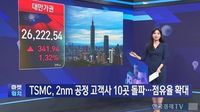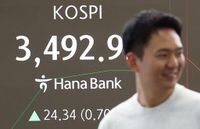Asian stock markets entered a new week on a bumpy ride, with investors across the region parsing a swirl of economic signals, corporate milestones, and policy uncertainties on September 23, 2025. The mood was unmistakably cautious, as inflation jitters, currency swings, and the ever-present specter of global interest rate hikes weighed on trading floors from Shanghai to Seoul.
Japan, usually a bellwether for regional sentiment, sat out the drama entirely—its exchanges were closed for the national holiday of Shubun no Hi, a day dedicated to honoring ancestors. But the absence of Tokyo’s trading bell didn’t dampen volatility elsewhere. According to Money Today, the Nikkei index was poised for a steep drop, reflecting concerns about the yen’s recent strength and persistent inflationary pressures. As of 11:40 AM Korean time, the Nikkei was down 1.25%, sitting at 26,204.58 points.
The real action, though, was in the rest of Asia. Chinese markets were in the spotlight as the Shanghai Composite index tumbled, falling 1.30% to 3,778.78 by early afternoon, as reported by Choice Economy. The losses were broad-based, with major stocks like Guizhou Maotai, Baoshan Iron & Steel, and China Life Insurance all in the red. The Hong Kong Hang Seng index mirrored the mainland’s unease, dropping 1.00% to 26,280.72 points. South China Morning Post pointed out that investor sentiment took a hit after People’s Bank of China Governor Pan Gongsheng declined to announce new stimulus measures at a press briefing the previous day, leaving markets hungry for support.
“Investor sentiment is clearly subdued,” noted South China Morning Post, “as the central bank refrained from unveiling immediate economic stimulus.” The lack of fresh policy action came even as the government had recently cut the reserve requirement ratio by 1% and introduced measures to shore up the struggling real estate market. These efforts, however, were not enough to stem the tide of profit-taking and sector rotation, especially as cash demand surged ahead of China’s National Day holidays.
Technology stocks, usually a source of optimism, weren’t spared. The STAR Market index, home to many of China’s tech darlings, slumped nearly 2%. Giants like Tencent, Alibaba, China Mobile, and Xiaomi all posted losses, reinforcing the sense that the region’s tech rally had hit a speed bump—at least for now.
Yet, not all corners of Asia were flashing red. Taiwan’s stock market bucked the trend, with the Taiex index climbing 1.25% to 26,204.58 points by midday, according to Money Today. The star of the show was TSMC, the world’s largest semiconductor foundry, which announced it had achieved a major milestone: the successful commercialization of its 2-nanometer chip process. TSMC confirmed it had secured orders from ten major customers even before mass production began, a technological leap that sent its shares—and the broader index—soaring to fresh record highs. As Wow TV put it, “TSMC’s 2nm breakthrough has once again rewritten what’s possible in chip manufacturing.”
This semiconductor surge wasn’t happening in a vacuum. The global AI boom continued to reverberate, with Naver D, a Korean AI startup, unveiling a bold strategy to compete with the likes of ChatGPT. On September 22, Naver D announced a 100 billion won (about $140 million USD) investment in artificial intelligence, drawing attention from industry heavyweights like TSMC and fueling a rally in related stocks.
Meanwhile, the United States set the tone for global markets the previous day, as the Dow Jones, S&P 500, and Nasdaq indices all closed at or near record highs. CNBC reported that the S&P 500 and Nasdaq Composite were lifted by a surge in tech shares, with Nvidia’s stock jumping nearly 4% after it announced a strategic partnership with OpenAI and a massive $100 billion investment in AI infrastructure. Apple shares also climbed by over 4% following positive reviews for the iPhone 17, adding fuel to the bullish fire. Tesla gained 1.91%, while Meta edged down by 1.63%. The US dollar, interestingly, weakened against a basket of major currencies, with the ICE Dollar Index falling 0.31% to 97.34 at the close of trading.
Back in Asia, the Korean stock market offered a rare bright spot. The KOSPI index broke through the 3,480 mark to set another all-time high, buoyed by foreign investors snapping up blue-chip shares. Samsung Electronics, SK Hynix, Hyundai Motor, Celltrion, Doosan Enerbility, and Kia all posted gains, reflecting confidence in Korea’s technology and manufacturing sectors. As Choice Economy observed, “Foreign buying is driving the KOSPI to new heights, even as other Asian markets falter.”
Elsewhere, Vietnam’s stock market managed to shake off a 20% drop in exports to the US—triggered by new American tariffs—and reversed a five-day losing streak, stabilizing around the 1,640 level. This resilience stood out, especially given the headwinds facing other Southeast Asian economies.
Despite these pockets of optimism, the broader picture remained one of caution. Investors across Asia were bracing for a slew of upcoming economic data releases, wary of how inflation, currency volatility, and shifting government policies might shape the next chapter. The US’s restrictions on semiconductor exports to China (amounting to about a 20% reduction) continued to disrupt supply chains and cloud the outlook for tech manufacturing, as noted by Wow TV. Meanwhile, the rapid pace of AI development—both in the US and Asia—kept market watchers guessing about which industries might be transformed next.
Underlying all this was a sense that the world’s financial centers are more interconnected than ever. Moves in one market sent ripples across continents, with technology breakthroughs, policy tweaks, and even holiday closures in one country influencing sentiment elsewhere. As the day wore on, traders and analysts alike found themselves glued to their screens, watching for the next headline that might tip the balance.
With so many moving parts—geopolitics, technology, macroeconomics—the only certainty seemed to be uncertainty itself. Investors will no doubt be keeping a close eye on the next round of data, policy pronouncements, and corporate developments, hoping for a clearer signal in the noise. For now, Asia’s markets remain a study in contrasts: pockets of exuberance amid a landscape of caution, and a constant reminder that in finance, fortunes can turn on a dime.

